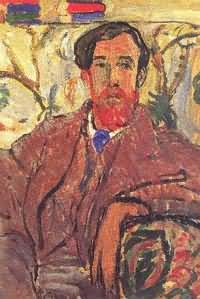Lytton Strachey
A Short biography of (Giles) Lytton Strachey

The British biographer and essayist was first sent to French school for girls in Wimbledon, then to Abbotsholme School. He then went to Leamington College and Liverpool University where he studied history. In 1899 he also went to Trinity College, Cambridge, where he became a member of the Apostles and he began life-long friendships with G. E. Moore, John Maynard Keynes, E. M. Forster, Leonard Woolf, and Clive Bell who later became members of the Bloomsbury Group. He also had long, leisurely, intimate conversations with Thoby Stevens, Virginia Woolf's brother. He left Cambridge in 1905, however, he often visited over the following years to take part in the intellectual life, and to be with John Maynard Keynes who had become one of his lovers. One of the young men that he was attracted to was his cousin Duncan Grant.
In 1917 he bought a large country house near Hungerford, Berkshire, where for the last 16 years of his life he was in a ménage à quatre with the painter Dora Carrington, her husband Ralph Partridge - 'with dancing blue eyes' - and his lover Frances Marshall. Occasionally another member of the household was Lytton Strachey's sometime lover Roger Senhouse, then in his 20s.
[With thanks to the The Knitting Circle at South Bank University, for much of the factual information contained here.]
The Letters of Lytton Strachey
edited by Paul Levy, have just been published [31 March 2005] by Penguin / Viking @ £30, ISBN 0670891126. Levy is co-executor of Lytton Strachey’s literary estate.
There were letters and extracts from the book published in the Telegraph, on 14 March 2005.
Hilary Spurling wrote in the Telegraph:
"It starts with Strachey in his early twenties, circulating stories like the one about the school tart, who locked himself in the lavatory as the school train left the station so as to receive visits from every boy in the carriage before they all got out at Eton."
Here is Philip Hensher writing in The Spectator, where Lytton worked as a freelance reviewer:
"Much of Lytton’s amorous life is recorded here. Duncan Grant: ‘Oh dear, dear, dear, how wild, how violent, and how supreme are the things of the earth!’ ... Duncan again: ‘I copulated with him again this afternoon, and at the present moment he’s in Cambridge copulating with Keynes.’ ... In the end, there was a most curious relationship with Roger Senhouse — ‘dreadfully fat’ — of a violently sado-masochistic variety, including not only whippings and beatings, and ... a crucifixion [of Strachey by] Senhouse.
Here he is, writing to Leonard Woolf, about an afternoon on Hampstead Heath with Duncan in 1905"
You can imagine the discomfort and the absurdity, but can you imagine the exquisite splendour of our embraces? It was the grand triumph of innocence, goodness and love. I had hardly believed so much was possible; to be embraced so passionately, to be kissed so often, and not to know whether one was buggering or being buggered. Inimitable delight!
And David Jays writing in The Guardian
"Strachey is saved time and again by his keen sense of absurdity. He cruises a handsome tart in the National Gallery, before realising it's the Prince of Wales. He spots a working-class lad on the tube, wearing 'a heavenly shirt, which transported me. It was dark blue with a yellow edge at the top, and it was done up with laces which tied at the neck'. This garment is the man's football shirt, from the Express Dairy team."
Hilary Spurling again:
"Strachey in his forties was still sending suggestive messages to Dorelia John about her pre-pubescent stepsons, and reporting enterprising attempts by a friend holidaying in Morocco to negotiate the purchase of a five-year-old boy."
Biographies on Lytton Strachey
Items marked * are available in the Lesbian & Gay Newsmedia Archive.
- Michael Holroyd (1967-68), "Lytton Strachey", 2 volumes, New York: Holt, Rinehart and Winston.
Book reviews- Scotsman, 4 Jan 1967* (Vol I)
- Isobel Murray writes:
"It is undeniably a good thing that in the post-Wolfenden era an honest biography can be written of a literary figure who happened also to be homosexual. but it seems to me also undeniable that if a man is not interesting in himself he does not become so because he indulges in extremely sentimental homosexual infatuations."
- Isobel Murray writes:
- The Times, 5 Oct 1967* (Vol I)
- Irish Times, 7 Oct 1967*
- Terence de Vere White writes:
"... a sedentary sodomite. ... The revelation of Maynard Keynes's sexual orientation is the sensation of the book"
- Terence de Vere White writes:
- Observer, 1 Oct 1967* (Vol I)
- Malcolm Muggeridge writes:
"One may be grateful (for once) to the permissive climate of the times which has tirade it possible for Mr Holroyd to describe these homosexual affairs with so much frankness and in so great detail; even a few years ago .... he would have felt bound to fall back on hints and innuendo."
- Malcolm Muggeridge writes:
- Listener, 12 Oct 1967* (Vol I)
- Geoffrey Grigson writes:
"..this open biography of a notable queer..."
- Geoffrey Grigson writes:
- Sunday Express, 1 Oct 1967* (Vol I)
- News of the World, 17 Feb 1968*
- Irish Times, 17 Feb 1968*
- Sunday Express, 18 Feb 1968* (Vol II)
- New Statesman, 23 Feb 1968* (Vol II)
- Saturday Review, 27 April 1968*
- Montreal Star, 27 April 1968*
- Newsweek, 29 April 1968*
- Time, 10 May 1968*
- Ottawa Citizen, 11 May 1968*
- Christian Science Monitor, 16 May 1968*
- Scotsman, 4 Jan 1967* (Vol I)
- John Ferns (1988) "Lytton Strachey", Twayne, ISBN 0805769668
- Michael Holroyd (1994), "Lytton Strachey:", Vintage, ISBN 0099332914 (paperback)
- Michael Holroyd (1995), "Lytton Strachey: The New Biography", Noonday Press ISBN 0374524653
Films
- Carrington (1995), directed by Christopher Hampton
is based on the book "Lytton Strachey" by Michael Holroyd.